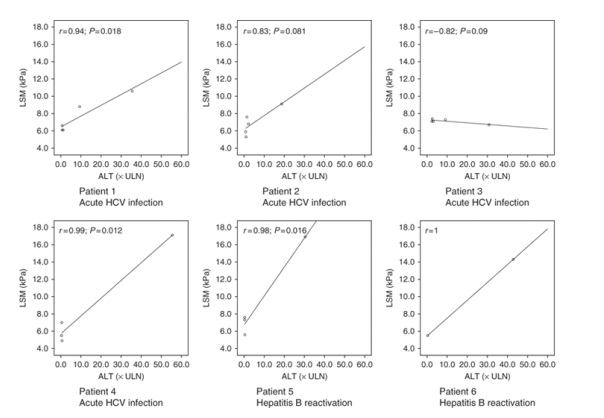| |
Influence of aminotransferase values on liver stiffness measurement: the case of HIV-infected patients with acute viral hepatitis B or C
|
| |
| |
LETTER TO THE EDITOR
HIV Medicine
Volume 10, Issue 1, Pages 62-63
Published Online: 16 Dec 2008
P Miailhes 1,2 , P Pradat 1,2,3 and C Trepo 1,2,3
1 Hospices Civils de Lyon, Hotel Dieu, Service d'hepatologie et de gastroenterologie, Lyon, France, 2 Universite Lyon 1, IFR62 Lyon-Est, Lyon, France and 3 INSERM, U871, Lyon, France
Correspondence: Dr Patrick Miailhes, Service d' Hepatogastroenterologie, Hotel-Dieu 1 place de l'hopital, 69288 Lyon cedex 02, France.
Transient elastography is a noninvasive technique for evaluation of liver stiffness. This tool has good diagnostic accuracy for the identification of significant fibrosis (METAVIR≥F2) and especially cirrhosis in patients with chronic hepatitis C [1]. However, data on the influence of aminotransferase values on liver stiffness measurement (LSM), particularly in cases of acute hepatitis, are scarce [2].
Recently, two studies reported by Arena et al. [3] and Sagir et al. [4] evaluated liver stiffness in 18 and nine patients with acute viral hepatitis, respectively, without a previous clinical history of liver disease. In both studies, increased values of LSM correlated with increased values of aminotransferases with a progressive reduction of LSM in parallel with the aminotransferase decline. Both these studies excluded HIV-infected patients and so no conclusions in this particular setting can be drawn from their results.
We report here a study conducted in six homosexual HIV-infected patients: four with acute hepatitis C and two with hepatitis B reactivation. Two to five LSMs were performed for each patient, during the acute phase of hepatitis and then during biochemical remission. The median duration of follow-up was 9 months (range 8-15 months), the median age was 43 years (range 34-57 years) and the median body mass index was 22 kg/m2 (range 20-22 kg/m2). All four acute cases of hepatitis C occurred under highly active antiretroviral therapy (HAART) with undetectable HIV RNA and a high median CD4 count (595 cells/_L). Conversely, the two subjects with hepatitis B reactivation had low CD4 cell counts (178 and 332 cells/_L, respectively) because one had stopped HAART 30 months before and the other had poor antiretroviral adherence.
In the two patients with hepatitis B, we performed a liver biopsy during the acute phase. At this time, when biochemical activity was high, with median alanine aminotransferase (ALT) values of 31 and 43 times, respectively, the upper limit of normal, LSM values were elevated, erroneously suggesting cirrhosis in both cases (17.1 and 16.9 kPa, respectively). Interestingly, the METAVIR fibrosis scores were only F2 and F1, associated with lesions of acute hepatitis (high inflammatory process with a METAVIR activity score of A3 in both cases). Later, when ALT normalized under anti-hepatitis B virus therapy, LSM returned to values in accordance with the initial histology: 7.3 kPa at 9 months and 5.5 kPa at 15 months, respectively.
For the four patients with acute hepatitis C, we performed four (one patient) or five (three patients) LSMs. The first LSM was performed during the acute phase of hepatitis, with subsequent LSMs 3 months later before HCV treatment for three of the patients, and during HCV therapy at 1, 3 and 6 months for all patients. Biopsies were not carried out in any of these patients, because liver biopsy is usually not recommended in acute HCV infection. After 3 months of follow-up, all these patients had persistently positive HCV RNA (acute hepatitis with HCV genotype 1 for two patients and genotype 3 or 4 for the other two patients). They then received a standard combination of pegylated interferon and ribavirin for 6 months. At the end of HCV treatment, the last LSM was performed, at which time ALT was found to be normalized in three patients.
Pooling the results for all patients, a strong correlation appears between LSM and ALT values (Pearson r=0.86; P<0.001), suggesting a probable overestimation of the fibrosis score in the presence of high ALT values.
Moreover, in the patients individually (Fig. 1), we found a significant positive correlation between LSM and ALT values for four patients and a positive trend for another. There was a negative trend for one patient (patient 3, with acute HCV infection).
Fig. 1 Relationship between alanine aminotransferase (ALT) values and liver stiffness measurements (LSMs) for each HIV-infected patient with acute hepatitis C virus infection (patients 1-4) or with hepatitis B reactivation (patients 5 and 6). kPa, kilopascals; _ ULN, times the upper limit of normal.

In conclusion, we confirm that, in the setting of HIV coinfection, the findings of Arena et al. [3] and Sagir et al. [4] still hold true. That is, in an acute necro-inflammatory process such as acute or reactivating viral hepatitis, the LSM is modified and could significantly overestimate liver fibrosis [5].
References
1 Castera L, Forns X, Alberti A. Non-invasive evaluation of liver fibrosis using transient elastography. J Hepatol 2008; 48: 835-847.
2 Coco B, Oliveri F, Maina AM et al. Transient elastography: a new surrogate marker of liver fibrosis influenced by major changes of transaminases. J Viral Hepat 2006; 14: 360-369.
3 Arena U, Vizzutti F, Corti G et al. Acute viral hepatitis increases liver stiffness values measured by transient elastography. Hepatology 2008; 47: 380-384.
4 Sagir A, Erhardt A, Schmitt M, Haussinger D. Transient elastography is unreliable for detection of cirrhosis in patients with acute liver damage. Hepatology 2008; 47: 592-595.
5 Cobbold JFL, Taylor-Robinson SD. Transient elastography in acute hepatitis: all that's stiff is not fibrosis. Hepatology 2008; 47: 370-372.
|
|
| |
| |
|
|
|